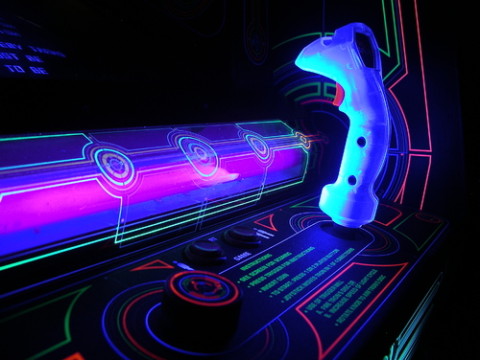Originally published in Las Vegas Citylife on August 8, 2013
I stood before the cabinet, tapping buttons, idly moving the grimy joystick from side to side, frowning at the faded artwork and cigarette-burned control panel. The cabinet had spent time outdoors, maybe in a shed, with water damage along the bottom and busted up corners. The weathered back door sat off to the side, revealing a rat’s nest of wire (along with what might have been an actual rat’s nest) and dust-covered main boards. I slid in a quarter. A loose connection somewhere echoed noisily in the speakers as the game’s theme began to play, misaligned text on the screen inviting me to have a go. The machine was a mess, but it worked.
“Will ya take three hundred?â€
This week! Bring an old arcade game to life for fun and profit!
In the summer of 2008, I restored TRON. I’d been a fan of the game and franchise since I was young, and one of my earliest gaming memories was wandering into the Disneyland Starcade as a child and seeing a row of brand new TRON arcade machines lined up along a wall, each one topped with a second monitor so that spectators could watch from the crowd. The game itself was attractive (four different games, all in one machine!) but what really captured me was the electronic music and the soft neon glow of the artwork, panels, and joystick. I was in awe.
Who knew that roughly 25 years later I’d have one sitting in my garage. It was in rough shape, sure, but it was TRON, and I was going to make it new again. I began the teardown in earnest, stripping down the cabinet while scouring forums and manuals, learning just enough to continue as I moved from task to task. And as I worked, I realized, this was a hell of a lot of fun.
The following summer, I tackled a pinball machine. Then a Neo-Geo cabinet. Then a Missile Command. Up next, pending time and workspace: a pair of mid 1980’s era Japanese arcade cabinets, short and squat and built like washing machines.
Look, you’ve read this far, you’ve gotta be at least a little bit driven by nostalgia, right? Is there an arcade game in your past that you remember fondly? Ever considered yourself the tinkering sort? Buy an old arcade cabinet. Park your car in the driveway for a couple months and dedicate the garage space to a restoration project. These things are only getting older, and it’s going to be up to the collectors and restorers to ensure they stick around.
Let me help you get started.
First off, be patient. So you’ve decided that yes, you’re going to try this. Awesome, but don’t just buy the first machine that pops up on Craigslist. Pricing for arcade games is all over the place, and unless you’re looking at an incredibly rare machine, don’t pay over a couple hundred dollars for a game that you plan to overhaul.
Don’t do this to make money. With the cost of parts and the time involved, the last thing you should expect to do is restore a game and sell it for profit.
Once you’ve got the machine, label everything. If you’re undertaking a ground-up restoration, the first thing you’ll want to do is take the cabinet apart. Don’t assume that you’ll remember anything about how it goes back together, because chances are you won’t. Have plenty of painter’s tape (label those pieces!), baggies, and Sharpies on hand. Take photographs. Start by photographing the cabinet and internals before removing a single screw, just to have a reference point. Photograph all plugs, connectors, and anything else that comes apart.
Tools-wise, you can pretty much dismantle a cabinet with a couple of screwdrivers and a socket set. A wire crimper and multimeter will be handy when you’re putting everything back together. If you are repainting, Citristrip is your friend. Invest in a decent sander, and paint with oil-based paints. If you need to repair damaged corners or other parts of the cabinet, use Bondo, it’ll outlast wood filler.
Take advantage of the community! Plenty of online discussion boards are out there. Some of the best for the budding restorer include the arcade-museum.com forums and the Build Your Own Arcade Controls community at forum.arcadecontrols.com. Both will lead you to useful background information, discussions, and even sources for cabinet parts and reproduction artwork.
Above all, don’t be intimidated. With all the available resources online, restoring an arcade cabinet is like building a model; you’ll find walkthroughs and guides for almost everything. The pleasure of restoration is that it forces you to learn a little bit about a lot of skills: a little bit of woodworking, a little bit of painting, a little bit of electronics. Dive in, have fun, and send me photos when you’re done.
